 |
by Lars Andersen and John Vergo.
Butterflies of Northern Europe is a unique, comprehensive reference work that fits in your pocket.
The app contains detailed descriptions of the 168 butterfly species found in northern Europe, from northern France in the south to Greenland in the north. Written by butterfly experts Lars Andersen and John Vergo, the meticulous content covers everything from a species' appearance to its distribution and habits, illustrated with photos of the male, female, eggs, caterpillars and host plants, together with flight period charts and distribution maps. The 31 comparison panels show different but easily confused species side by side, and their distinguishing characteristics are highlighted and described with hitherto unseen precision in over 300 photos with arrowed references and captions.
You can write notes on each species and add your sightings to a trip list to keep track of the day’s observations and even share them with others by SMS, email or social media. The app does not require an Internet connection, so it works in the field, too.
The search function makes it easy to track down a particular species by criteria such as size, colours and wing shape, making it a simple matter to find and identify that species you saw while out and about. With its many functions and in-depth content, this app is both a field guide that goes everywhere with you and a unique, beautifully illustrated work of reference.
Butterflies of Northern Europe is a new App, available in English, with comprehensive details regarding 168 butterfly species which can be found north of a line stretching from Brittany in the west to Arkhangelsk, Russia, in the east, and incorporating the Baltics, Scandinavia and even Greenland.
The majority of those who visit Europe to look for butterflies tend to do so in the more southern areas of the continent, but whilst this App has niche appeal as a result, it is nonetheless a useful resource and is simple to use and possesses a user-friendly layout.
On the right side of the header there is a facility whereby the user can find general information about the App, including details of the authors, the morphology of butterflies and a useful feature where users can record any trips they make.
There are five features on the main page, with users being able to find butterflies alphabetically, or via family or sub-family. There is also a search facility to enable species to be found individually.
On the respective species pages, there is a welcome tool which allows the user to view multiple images of the species (including early stages) to assist in differentiating the sexes or identifying it by means of the underside view. In addition, there are often habitat images to better inform the user of what kind of environment the butterfly is likely to be found in.
For each species there is a clear image of the butterfly at the top of the page, with a detailed description of its size and characteristics. Any species it might possibly be confused with are named below, following which is a commentary on the habitat preferred by the butterfly and the behaviour it exhibits.
 | 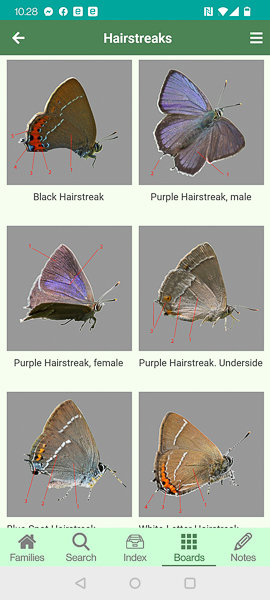 | 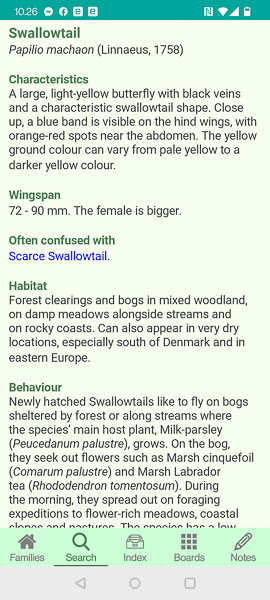 |
A phenological chart then indicates the stage of the insect in each month of the year, followed by a distribution map for the area covered by the App as well as a written section which explains this distribution in greater detail. At the bottom of the page, there is a handy table giving the name of the species in a variety of European languages.
There is also an interactive segment near the top of the page which the user can access to add any notes they wish to write or to record the sighting as part of a trip. These can then be shared via SMS, email or via social media should the user wish to.
Clearly, a lot of attention to detail has gone into creating this App and the information contained within it is very comprehensive. The images to support the species are of excellent quality and the layout and format are simple to follow and easy to navigate.
The distribution maps for each species can be selected and enlarged if the user wishes to focus on a particular area, as can the phenological chart.
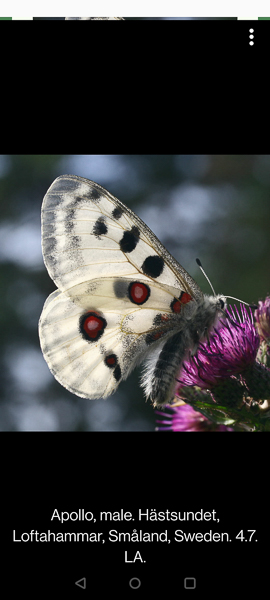 | 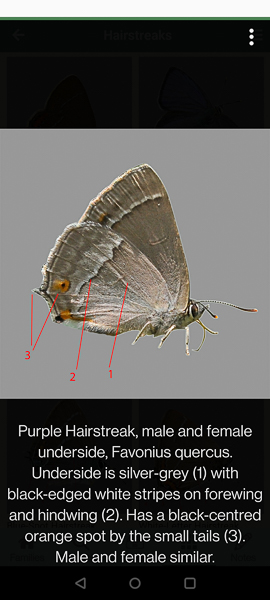 |
The ‘Boards’ section is also extremely useful. It provides details of the identifying characteristics of all the butterfly species and groups them into sub families which are quick and easy to access. This is something generally not found even in large guide books so the creators deserve credit for this feature.
Overall, this App would be an excellent and informative accompaniment for any butterfly enthusiast visiting the area covered by the guide. The information it contains covers all the essential elements and a bit more besides. It is well thought out, well laid out and excellently illustrated.
The app is available for download for iOS and Android. Scan the QR Code below for your device. Alternatively, select the appropriate link.
 |
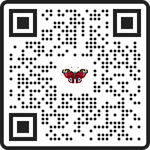 |